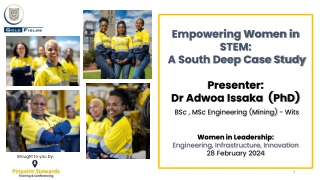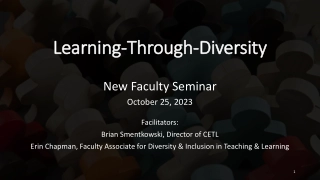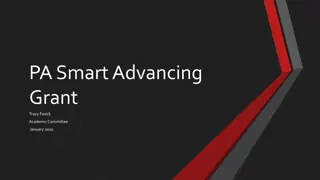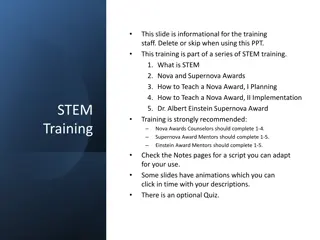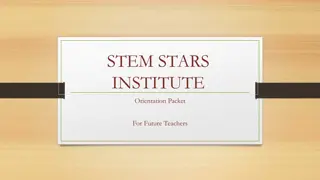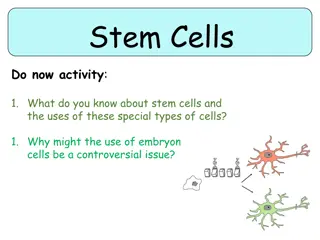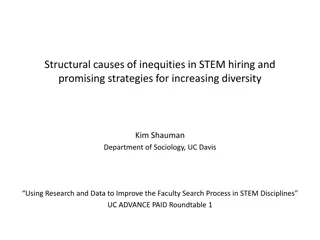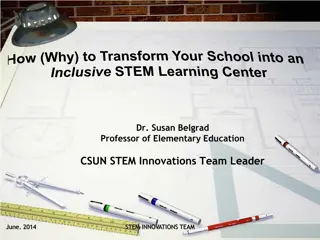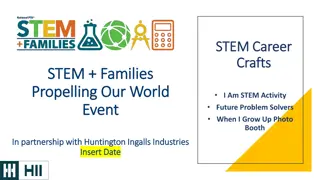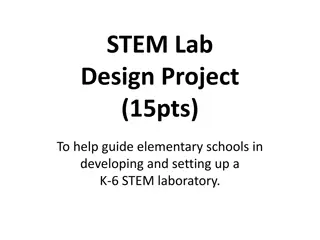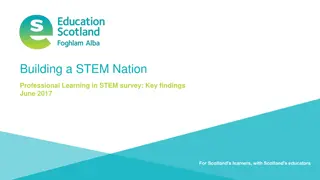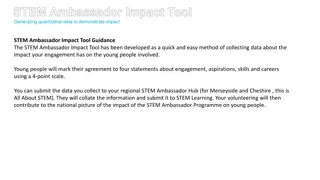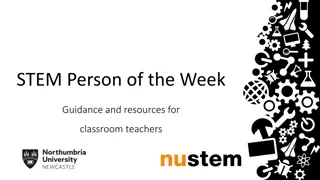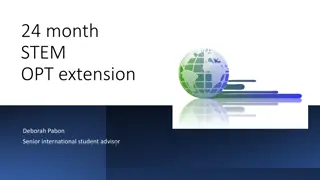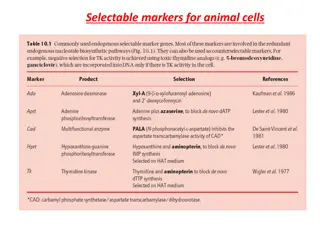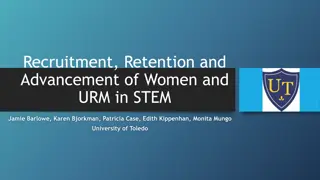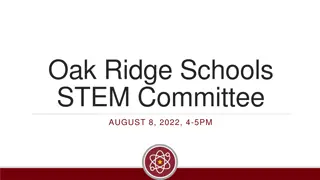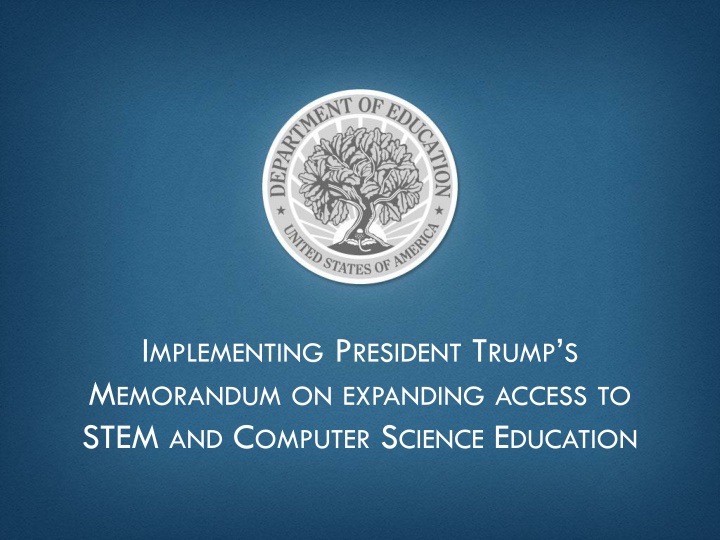
President Trump's STEM & Computer Science Education Initiative Overview
Explore the implementation of President Trump's memorandum to expand access to STEM and computer science education, including details on grant funds, competitions, and the Supporting Effective Educator Development (SEED) program. Learn about key components, eligibility criteria, and the history behind this initiative.
Download Presentation

Please find below an Image/Link to download the presentation.
The content on the website is provided AS IS for your information and personal use only. It may not be sold, licensed, or shared on other websites without obtaining consent from the author. If you encounter any issues during the download, it is possible that the publisher has removed the file from their server.
You are allowed to download the files provided on this website for personal or commercial use, subject to the condition that they are used lawfully. All files are the property of their respective owners.
The content on the website is provided AS IS for your information and personal use only. It may not be sold, licensed, or shared on other websites without obtaining consent from the author.
E N D
Presentation Transcript
IMPLEMENTING PRESIDENT TRUMPS MEMORANDUM ON EXPANDING ACCESS TO STEM AND COMPUTER SCIENCE EDUCATION
BACKGROUND PRESIDENT S STEM & COMPUTER SCIENCE DIRECTIVE In Fall 2017, President Trump released a memorandum directing ED to devote at least $200 million in grant funds per year to promote high-quality STEM education, including Computer Science. ED is using its existing discretionary grant programs and the Secretary s STEM Supplemental Priority to actionize the President s $200M directive. The notice inviting applications (NIAs) for discretionary/ competitive grants are starting to be published in the Federal Register. The applicants who are selected as winners will receive funding this fall. 2
2018 COMPETITIONS OVERVIEW SUPPORT FOR STEM/COMPUTER SCIENCE Program Support for STEM/Computer Science Supporting Effective Educator Development (SEED) Competitive Preference Priority providing extra points to applicants who propose to support educators in STEM fields, including Computer Science. Education Innovation and Research (EIR) Absolute Priority supporting Field Initiated STEM/CS Innovative projects. Invitational Priority on Personalized Learning. Office of Career, Technical, and Adult Education (OCTAE) Funding opportunity to promote apprenticeships in STEM fields for high school students. 3
Supporting Effective Educator Development 2018 Competition Overview Note: These slides are intended as guidance only. Please refer to the official Notice published in the Federal Register.
SEED PROGRAM OVERVIEW Originally authorized in the FY2011 Appropriation Act for the Department. Current version of program authorized in 2015 under the Every Student Succeeds Act. See the Awards page on our website for past and current grantees. History To provide grants to increase the number of highly effective educators by supporting the implementation of Evidence-Based preparation, professional development, or professional enhancement opportunities for educators. Purpose 5
SEED PROGRAM OVERVIEW 2018 KEY COMPONENTS Component Description National Nonprofit Organizations (NNO), Institutions of Higher Education (IHE), Bureau of Indian Education, For-Profits partnering with NNO or IHE Eligible Entities AP1: Supporting Effective Teachers AP2: Supporting Effective Principals or Other School Leaders CPP: Promoting STEM Education w/ a Particular Focus on CS IP: Support for the Use of Micro-Credentials Priorities Required Evidence AP1: Moderate Evidence AP2: Promising Evidence Project Length 3-year project period with possibility of 2-year extension Matching 25% of Total Project Cost (33% of Federal Funds) 6
PRIORITIES Competitive Priority Absolute Priorities Promoting Science, Technology, Engineering, and Math (STEM) Education, With a Particular Focus on Computer Science ME AP 1: Supporting Effective Teachers PE AP 2: Supporting Effective Principals or Other School Leaders Invitational Priority: Support for the Use of Micro-Credentials Must either address AP1 or AP2, not both. May address any combination of CPP or IP. 7
PRIORITIES Applicants must clearly identify the priorities for which they are applying. Applicants approaches to the Absolute Priorities will be reviewed and receive points based on the selection criteria. Applicants may receive up to 3 additional points based on how well they address the Competitive Preference Priority, at the discretion of reviewers. Applicants do not receive any competitive advantage or points for their response to the Invitational Priority. Specific wording for priorities may be found in the NIA on the SEED website: https://innovation.ed.gov/what-we-do/teacher-quality/supporting-effective- educator-development-grant-program/applicant-info-and-eligibility/ 8
ABSOLUTE PRIORITIES ABSOLUTE PRIORITY 1: SUPPORTING EFFECTIVE TEACHERS This priority is for projects that will implement activities that are supported by Moderate Evidence. Moderate Evidence (1) Providing teachers from nontraditional preparation and certification routes or pathways to serve in traditionally underserved LEAs; (2) Providing teachers with Evidence-Based Professional Development activities that address literacy, numeracy, remedial, or other needs of LEAs and the students the agencies serve; or (3) Providing teachers with Evidence-Based professional enhancement activities, which may include activities that lead to an advanced credential. Primary Priority Areas 9
ABSOLUTE PRIORITIES ABSOLUTE PRIORITY 2: SUPPORTING EFFECTIVE PRINCIPALS AND OTHER SCHOOL LEADERS This priority is for projects that will implement activities that are supported by Promising Evidence. Promising Evidence (1) Providing principals or other School Leaders from nontraditional preparation and certification routes or pathways to serve in traditionally underserved LEAs; (2) Providing principals or other School leaders with Evidence-Based Professional Development activities that address literacy, numeracy, remedial, or other needs of LEAs and the students the agencies serve; or (3) Providing principals or other School Leaders with Evidence-Based professional enhancement activities, which may include activities that lead to an advanced credential. Primary Priority Areas 10
COMPETITIVE PREFERENCE PRIORITY PROMOTING STEM EDUCATION, WITH A PARTICULAR FOCUS ON COMPUTER SCIENCE (0-3 PTS) Projects designed to improve outcomes in one or more of the following areas: science, technology, engineering, math, or Computer Science. Improving STEM or Computer Science Outcomes Increasing number of educators prepared to deliver rigorous instruction in STEM fields: (1) Recruitment (2) Evidence-Based Professional Development strategies, or (3) Evidence-Based retraining strategies. Possible Priority Areas 11
INVITATIONAL PRIORITY SUPPORT FOR THE USE OF MICRO-CREDENTIALS. Under this priority, we are interested in projects that support teachers, principals, or other School Leaders earning micro-credentials based on demonstrated mastery of specific skills or competencies through the use of performance-based outcomes. The micro- credentials should be portable across schools, LEAs, or States. Note: Invitational Priorities are used as exploratory priorities for ED to learn more about what the field is doing in that particular area. 12
EVIDENCE STANDARDS OVERVIEW Applicants under AP1: Supporting Effective Teachers will need to submit studies that meet the Moderate Evidence definition. Applicants under AP2: Supporting Effective Principals or Other School Leaders will need to submit studies that meet the Promising Evidence definition. Applicants may submit up to 2 citations to support their project. Three citation options: WWC Practice Guides Recommendation WWC Intervention Reports Publicly Available Studies (Teacher Training, Evaluation, and Compensation Evidence Review Protocol) 13
SELECTION CRITERIA OVERVIEW All selection criteria will be scored by peer reviewers. Quality of the Project Design: 35 points Significance: 20 points Quality of the Management Plan: 25 points Quality of the Project Evaluation: 20 points Grantees selected based on peer reviewer scores. Specific wording for each selection criterion may be found in the NIA at the SEED website: https://innovation.ed.gov/what-we-do/teacher-quality/supporting- effective-educator-development-grant-program/applicant-info-and- eligibility/ 14
APPLICATION TIMELINE Date Event 4/5/18 Intent to Apply Due 5/17/18 SEED Application Deadline Sept 2018 SEED Grants Awarded See the SEED website for updated information: https://innovation.ed.gov/what-we-do/teacher-quality/supporting-effective-educator- development-grant-program/applicant-info-and-eligibility/ We will still accept Intents to Apply after the deadline, though they are not required to be eligible to apply. Submit intents to apply here: www.surveymonkey.com/r/HZV7XQ6 Applications time stamped after 4:30:00 PM DC Time will not be reviewed. 15
IMPORTANT RESOURCES SEED Website: https://innovation.ed.gov/what-we-do/teacher-quality/supporting-effective- educator-development-grant-program/applicant-info-and-eligibility/ Notice Inviting Applications Application Package (sample) Additional SEED competition informational webinar recordings Evidence webinars and checklists Applications from Past Winners Evaluation Resources: https://innovation.ed.gov/what-we-do/teacher-quality/supporting- effective-educator-development-grant-program/evaluation-resources/ All questions about SEED may be sent to SEED@ed.gov 16
EDUCATION INNOVATION AND RESEARCH (EIR) 2018 COMPETITION OVERVIEW NOTE: THESE SLIDES ARE INTENDED AS GUIDANCE ONLY. PLEASE REFER TO THE OFFICIAL NOTICES PUBLISHED IN THE FEDERAL REGISTER.
WHO IS ELIGIBLE TO APPLY? Eligible Applicants: (a) A local educational agency (LEA); (b) A State educational agency (SEA); (c) The Bureau of Indian Education (BIE); (d) A consortium of SEAs or LEAs; (e) A nonprofit organization; and (f) An SEA, an LEA, a consortium described in (d), or the BIE, in partnership with-- (1) A nonprofit organization; (2) A business; (3) An educational service agency; or (4) An institution of higher education. Note: An LEA includes a public charter school that operates as an LEA. 18
EIR: A MODEL TIERED EVIDENCE GRANT PROGRAM Early-Phase Develops and tests innovative education practices practices and regionally or nationally scales those practices Applicants must demonstrate a rationale based on high quality research findings of evaluation Up to $4 million per award, up to 60 months (5 years) of funding (5 years) of funding 8-16 awards anticipated 4-10 awards anticipated 1-3 awards anticipated Mid-Phase Expansion Further develops innovative education Scales nationally those practices demonstrated to be effective Applicants must meet Moderate Evidence standard Applicants must meet Strong Evidence standard Up to $8 million per award, up to 60 months Up to $15 million per award, up to 60 months (5 years) of funding 19
KEY COMPONENTS OF EIR Issue Education Innovation and Research (EIR) 3 types of grants, with evidence determining the level of funding Local Educational Agency, State Educational Agency, Bureau of Indian Education, and Nonprofit Reserves 25% of funding for rural grantees serving rural areas Field-Initiated Priorities Tiered Evidence Structure Eligibility Rural Priorities Matching Requires 10% Matching 20
EARLY-PHASE GRANTS Grants support education practices that are new compared to others that are underway nationally. Applicants must demonstrate a rationale based on high quality research findings of evaluation Projects are encouraged to focus on continuous improvement and iterative development to increase potential effectiveness. Evaluations should determine whether the practices can successfully improve student achievement and attainment, particularly for high-need students. 21
EARLY-PHASE PRIORITIES REQUIRED: Everybody Must Address Absolute Priority 1 Absolute Priority 3 Absolute Priority 1: Demonstrates a Rationale General Absolute Priority 3 Field-Initiated Innovations Promoting STEM Education, with a Particular Focus on Computer Science REQUIRED: Applicants Must Also Select and Addresses Either Absolute Priority 2 or OPTIONAL: May select one, both, or neither Absolute Priority 2: Field-Initiated Innovations Invitational Priority 1: Personalized Learning Invitational Priority 2: Early Learning and Cognitive Development Note: No extra points will be awarded for addressing these invitational priorities. Note: This priority establishes an evidence requirement. Note: Must clearly indicate in the abstract and project narrative which option has been selected. 22
MID-PHASE GRANTS Grants support projects supported by moderate evidence. Grants aim to refine and expand use of practices, and to scale them to regional or national level. Grants aim to learn more about contexts in which the practices are most effective and cost-effective. Grants aim to build knowledge base of effective practices. Evaluations of projects aim to measure project impact with new populations and in new settings, and to identify the core elements that can be adopted or replicated by others. 23
MID-PHASE PRIORITIES REQUIRED: Everybody Must Address Absolute Priority 1 REQUIRED: Applicants Must Select Either Absolute Priority 2 or Absolute Priority 3 OPTIONAL: May select one, both, or neither Absolute Priority 1: Moderate Evidence Absolute Priority 2: Field-Initiated Innovations General Absolute Priority 3 Field-Initiated Innovations Promoting STEM Education, with a Particular Focus on Computer Science Note: Must clearly indicate in the abstract and project narrative which option has been selected. Invitational Priority 1: Personalized Learning Invitational Priority 2: Early Learning and Cognitive Development Note: No extra points will be awarded for addressing these invitational priorities. Note: This priority establishes an evidence requirement. 24
REMINDER: MID-PHASE GRANTEES ARE ENCOURAGED TO SCALE TO A REGIONAL OR NATIONAL LEVEL Regional (see definition in the notice inviting applications): Serve a variety of communities in a state or multiple states Serve different student groups If an LEA-based project, must serve students in more than one LEA National (see definition in the notice inviting applications): Serve a wide variety of communities Serve different student groups 25
EXPANSION GRANTS Grants support projects supported by strong evidence. Grants aim to identify the conditions in which the program is most effective. Grants should determine whether impacts can be successfully reproduced and sustained over time.. Grants are encouraged to be sustained and to continue to grow even after EIR funding ends. 26
EXPANSION PRIORITIES REQUIRED: Everybody Must Address Absolute Priority 1 Absolute Priority 1: Strong Evidence REQUIRED: Applicants Must Select Either Absolute Priority 2 or Absolute Priority 3 Absolute Priority 2: Field-Initiated Innovations General Absolute Priority 3 Field-Initiated Innovations Promoting STEM Education, With a Particular Focus on Computer Science Note: Must clearly indicate in the abstract and project narrative which option has been selected. OPTIONAL: May select one, both, or neither Invitational Priority1: Personalized Learning Invitational Priority 2: Early Learning and Cognitive Development Note: No extra points will be awarded for addressing these invitational priorities. Note: This priority establishes an evidence requirement. 27
REMINDER: EXPANSION GRANTEES ARE ENCOURAGED TO SCALE TO A NATIONAL LEVEL National level describes the level of scope or effectiveness of a process, product, strategy, or practice that is able to be effective ..in a wide variety of communities, including rural and urban areas, as well as with different groups (e.g., economically disadvantaged, racial and ethnic groups, migrant populations, individuals with disabilities, English learners, and individuals of each gender). 28
SELECTION CRITERIA OVERVIEW All selection criteria will be scored by peer reviewers. Early-phase Significance: 30 points Quality of the Project Design and Management Plan: 50 points Quality of the Project Evaluation: 20 points Mid-phase Significance: 15 points Strategy to Scale: 30 points Quality of the Project Design and Management Plan: 35 points Quality of the Project Evaluation: 20 points Expansion Significance: 10 points Strategy to Scale: 35 points Quality of the Project Design and Management Plan: 35 points Quality of the Project Evaluation: 20 points Grantees are selected based on peer reviewer scores. 29
REMINDER: ALL APPLICANTS MUST TARGET HIGH-NEED STUDENTS All applicants must target high-need students. Applicants may select one or more particular groups of high-need students to focus on in their projects. Not all students served in a project must be high need; but it must be a primary focus. 30
DATES TO REMEMBER Expansion (84.411A), Mid-phase (84.411B), and Early- phase (84.411C) applications Applications available: April 19th, 2018 Deadline for transmitting applications: 4:30:00 PM Washington DC time June 5th, 2018 Awards announced by: September 30th, 2018 31
OFFICE OF CAREER, TECHNICAL, AND ADULT EDUCATION (OCTAE)
HS TO STEM APPRENTICESHIPS - RESOURCES Framework on Registered Apprenticeship (RA) for High School Students - https://wdr.doleta.gov/directives/corr_doc.cfm?docn=4799 Planning Guide for Aligning CTE and Apprenticeship Programs - https://s3.amazonaws.com/PCRN/reports/Planning_Guide_f or_Aligning_CTE_and_Apprenticeship_Programs.pdf Work-Based Learning Toolkit - https://cte.ed.gov/wbltoolkit/ Visit the Perkins Collaborative Resource Network (PCRN) at https://cte.ed.gov ! 33
QUESTIONS? Type questions into the chat box. If you have additional questions after today contact: SEED Competition Manager: Rich Wilson (202) 453-6709 SEED@ed.gov EIR Competition Managers: Folake Reed and Irene Montanti (202) 453-7122 EIR@ed.gov OCTAE HS to STEM Apprenticeship Pathways Project Lead: Erin Berg (202)245-6792 Erin.Berg@ed.gov 34

